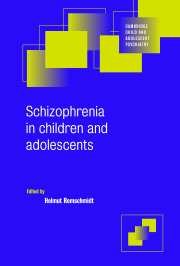Book contents
- Frontmatter
- Contents
- List of contributors
- Preface
- 1 Childhood psychosis and schizophrenia: a historical review
- 2 Definition and classification
- 3 Epidemiology of early onset schizophrenia
- 4 Childhood schizophrenia: developmental aspects
- 5 Diagnosis and differential diagnosis
- 6 Genetic aspects
- 7 Neurobehavioral perspective
- 8 Psychosocial factors: the social context of child and adolescent onset schizophrenia
- 9 Treatment and rehabilitation
- 10 Course and prognosis
- Index
9 - Treatment and rehabilitation
Published online by Cambridge University Press: 23 October 2009
- Frontmatter
- Contents
- List of contributors
- Preface
- 1 Childhood psychosis and schizophrenia: a historical review
- 2 Definition and classification
- 3 Epidemiology of early onset schizophrenia
- 4 Childhood schizophrenia: developmental aspects
- 5 Diagnosis and differential diagnosis
- 6 Genetic aspects
- 7 Neurobehavioral perspective
- 8 Psychosocial factors: the social context of child and adolescent onset schizophrenia
- 9 Treatment and rehabilitation
- 10 Course and prognosis
- Index
Summary
Neuroleptic (antipsychotic) agents and their properties
Typical or classical neuroleptics are agents with an antipsychotic effect that have been introduced into clinical practice since the antipsychotic effect of chlorpromazine was detected (Delay et al., 1952). In consequence of this discovery, several other neuroleptics (high potency typical neuroleptics) were developed that had stronger antipsychotic properties, mainly on productive (positive) symptoms, but had no advantage according to the improvement of negative schizophrenic symptoms. At the same time they caused more severe extrapyramidal side effects (EPS) such as acute dystonia, parkinsonism, akathisia, and tardive dyskinesia. These observations led to the hypothesis that the antipsychotic efficacy is closely related to the development of EPS. The introduction of these classical, high potentcy, neuroleptics was a revolution in the treatment of schizophrenia and related disorders. It was soon revealed that, in spite of a good effect in the majority of schizophrenic cases, between 30 and 40% of the patients did not respond to the neuroleptic medication mainly caused by the persistence of negative schizophrenic symptoms. These so-called non-responders or pharmaco-resistant patients are still an enormous problem in clinical psychiatry. The reported rate of non-responders in adult psychiatry is similar to that found in child and adolescent psychiatry, where about 40% of the children and adolescents with schizophrenia do not respond to classical neuroleptic medication (Remschmidt, 1993a,b). A new era of pharmacological treatment has been opened up with the introduction of atypical antipsychotics such as clozapine. Up to 60% of non-responders to typical neuroleptics improved under clozapine.
Keywords
- Type
- Chapter
- Information
- Schizophrenia in Children and Adolescents , pp. 192 - 267Publisher: Cambridge University PressPrint publication year: 2000
- 5
- Cited by



